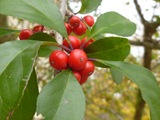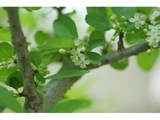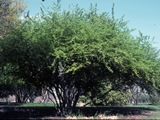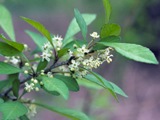Focus on a Native: Possumhaw Holly
by CMG Betty J
 Adorned in bright red berries in winter, Possumhaw Holly, Ilex decidua, is the widest-ranging holly that is native to Texas. It grows from Maryland and the Florida panhandle to the western edges of Texas. Its favored habitats include swampy lowlands, river bottoms and coastal plains in clay, loam or caliche soils. These are small trees, seldom growing to more than 30’ but more frequently appearing as a large shrub with several stems. Some other names by which this tree is known are Deciduous Holly, Meadow Holly, Prairie Holly, Swamp Holly, Welk Holly, Bearberry and Winterberry.
Adorned in bright red berries in winter, Possumhaw Holly, Ilex decidua, is the widest-ranging holly that is native to Texas. It grows from Maryland and the Florida panhandle to the western edges of Texas. Its favored habitats include swampy lowlands, river bottoms and coastal plains in clay, loam or caliche soils. These are small trees, seldom growing to more than 30’ but more frequently appearing as a large shrub with several stems. Some other names by which this tree is known are Deciduous Holly, Meadow Holly, Prairie Holly, Swamp Holly, Welk Holly, Bearberry and Winterberry.
 The leaves are dull green, deciduous, smooth, round at the tip and 1½ – 3” long with round teeth along the edges. The leaves remain green throughout autumn. Small white flowers bloom in March-May, have four petals on thin stalks at the end of small twigs. Male and female plants are separate, and the male trees do not have berries. The bark is brown, thin and smooth but becomes rougher as the tree ages.
The leaves are dull green, deciduous, smooth, round at the tip and 1½ – 3” long with round teeth along the edges. The leaves remain green throughout autumn. Small white flowers bloom in March-May, have four petals on thin stalks at the end of small twigs. Male and female plants are separate, and the male trees do not have berries. The bark is brown, thin and smooth but becomes rougher as the tree ages.
 The fruit of Ilex decidua is small, round and green. It contains several grooved seeds (nutlets) and is technically a drupe (a fleshy fruit such as a cherry) but is commonly called a berry. The berries grow in clusters and ripen to a bright red-orange in fall; they remain on the tree throughout the winter and provide a good food source for birds and small mammals. Deer sometimes browse Possumhaw leaves.
The fruit of Ilex decidua is small, round and green. It contains several grooved seeds (nutlets) and is technically a drupe (a fleshy fruit such as a cherry) but is commonly called a berry. The berries grow in clusters and ripen to a bright red-orange in fall; they remain on the tree throughout the winter and provide a good food source for birds and small mammals. Deer sometimes browse Possumhaw leaves.
 Landscapers often choose Possumhaw Holly as an understory plant because of their compact growth pattern, interesting foliage, conspicuous flowers and year-round interest. Although fast growing, they may be short lived. The berry branches are used in holiday decorations. Propagation by seed is possible but germination is more successful if the seeds are planted soon after collection. It may take years for them to germinate. Plants are available commercially.
Landscapers often choose Possumhaw Holly as an understory plant because of their compact growth pattern, interesting foliage, conspicuous flowers and year-round interest. Although fast growing, they may be short lived. The berry branches are used in holiday decorations. Propagation by seed is possible but germination is more successful if the seeds are planted soon after collection. It may take years for them to germinate. Plants are available commercially.